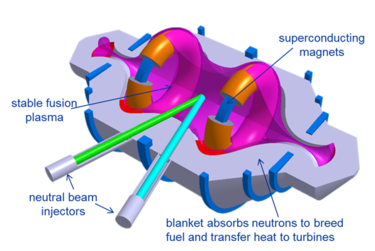I have blogged about nuclear fusion before. Scientists have been researching the possibility of generating energy by nuclear fusion, the energy source of stars, for decades. The basic concept of nuclear fusion is the combination of lighter elements into heavier elements accompanied by a huge release of energy.
Billions of dollars have been poured into this research but no fusion power generator has yet been constructed. There is a major international project called ITER which is using a well-known approach based on the Russian tokamak design. A tokamak is a donut shaped chamber surrounded by magnets to stabilize and energize the fusion reactions. This is a strictly proof of concept project where they are just trying to get to the point at which more energy is coming out of the generator that is being supplied to the generator. Billions more will be spent and years will pass before it is known if their approach will actual work. Recently there have been several companies working on very different approaches to nuclear fusion. The U.S. defense contractor Lockheed Martin is one of these companies.
Lockheed Martin is the Pentagon's biggest supplier. They have been research nuclear fusion for over sixty years and they have been working on a nuclear fusion project for the past four years at their Skunk Works laboratory. It is a "high beta fusion reactor" or "4th generation prototype T4" design for a compact fusion reactor (CFR).
In the Lockheed Martin CRF, two isotopes of hydrogen, deuterium and tritium are the fuel. Deuterium contains a single neutron in the nucleus along with the proton. In tritium, there are two neutrons in the nucleus. First the electrons are stripped off the deuterium and tritium atoms creating a plasma. Then the plasma is compressed and heated which overcomes the normal mutual repulsion of two nuclei. The hydrogen isotopes fuse into a helium atom and a energetic neutron. The energy is then transferred to a coolant that drives turbines to produce electricity. Deuterium is available in ocean water. Tritium, which is rare on Earth, can be produced in nuclear reactors. A CFR reactor will require very little fuel and will create very little nuclear waste compared to a fission reactor.
The LM CFR uses magnetic mirrors for confinement. It is about the size of a jet engine which permits a faster development cycle than giant reactors like ITER. One set of mirrors are rings at either end of the CFR cylinder and the other set wraps two rings around the CFR cylinder The first set pushes the plasma toward the center of the cylinder and the second set pushes the plasma toward the ends of the cylinder. The lack of any current flowing in the plasma removes the main source of plasma instabilities that have proven a major challenge for tokamak style reactors. The LM superconducting magnets reduce the size of the reactor to about a tenth the size of the tokamak design so a finished compact fusion power system could be small enough to fit on the bed of a truck for transport. Currently microwaves are used to heat the plasma for ignition but LM says that they are designing a system that will inject neutral deuterium atoms into the cylinder where their energy will transfer to the plasma.
LM recently released the news that they will build and test a compact fusion reactor in less than a year. They are aiming to have a working prototype of a commercial generator within five years and a commercial production model in ten years. After four years of secretive work on the CFR, LM is now looking for public and private partners to advance their fusion program.
Nuclear fusion has been promised for decades but actual development of a working system has been very difficult. With all the problems of nuclear fission power, nuclear fusion would be much cheaper and smaller with less fuel required and less waste generated. There are other designs that use other fuels that are more available and they don't generate any radioactive waste. With increasing demand for electricity, nuclear fusion would be a good way to supplement sustainable alternative sources with base-load power.
Lockheed Martin compact fusion reactor diagram:
